
If you aren't immersed in the world of high-end video game collecting, it's probably hard to understand why someone paid in excess of $1.5 million for a single, shrinkwrap-sealed boxed copy of Super Mario 64 last Sunday. But if you talk to people who have been collecting games and following this insular world for decades, you'll find... well, they also think it's hard to understand.
The confusing part isn't even the sheer amount of money being spent on a video game box that no one will ever open, much less play. Ever since an early sealed printing of Super Mario Bros. sold for over $100,000 in 2019, the general consensus in the world of high-end game collecting was that an eventual seven-figure game sale was inevitable. But even after a $660,000 Super Mario Bros. sale two months ago, many didn't think the flashy million-dollar barrier would be broken so quickly. "I honestly thought that this was a milestone that we wouldn't pass until years from now," Heritage Auctions Video Game Consignment Director Valarie McLeckie told Ars.More than the timing, though, game collectors that spoke to Ars expressed near-universal shock that this was the first game to command such a high price. In the past, the small handful of games that have sold for $100,000 or more have all been extremely rare and notable in some way. The Legend of Zelda that temporarily set an $870,000 sales record earlier in Heritage's recent weekend auction, for instance, was described in the listing as "the only copy from one of the earliest production runs that we've ever had the opportunity to offer" for an iconic game.
“I could understand the logic behind a lot of the expensive ones. This felt like the first one that I didn’t understand the ‘Why?’”Kelsey Lewin
Sure, Super Mario 64 is an important game in a franchise with a huge number of fans. But it's not the first home video game appearance of Mario—early printings of Super Mario Bros. are more analogous to Superman's first appearance in Action Comics #1, the holy grail of comic collecting.
And yes, it's hard to find a copy of the N64 best-seller that wasn't torn open and played immediately by some kid the second they got it in the late '90s. But it's not impossible. Over the last two years, clearinghouse PriceCharting.com lists 30 public sales of "graded" sealed copies of Super Mario 64 (i.e., those which have been evaluated and put in a protective slab by a rating agency). Dozens of additional sealed copies have been sold "raw" and ungraded in that time.
None of those sealed Super Mario 64 boxes sold for more than $38,400 before this $1.56 million sale.
"I thought that a lot of [these high-end sealed-game sales] made sense up until this last weekend," said Kelsey Lewin, co-director of the Video Game History Foundation and co-owner of retro game store Pink Gorilla. "I could understand the logic behind a lot of the expensive ones. This felt like the first one that I didn't understand the 'Why?'"
Long-time sealed-game collector Bronty, who sold that $100,000 Super Mario Bros. two years ago, put a finer point on it. "A $400K result I might have understood. $1.5 million? What the fuck?"Twilight of the completionists
"What's basically happening is that people are getting in with a lot more money in their pockets than has been going around in game collecting so far," says former Wired gaming editor and current Digital Eclipse Editorial Director Chris Kohler. "And they're saying, 'You guys are doing it wrong.'"
Kohler has been collecting video games since he was a teenager in the '90s, or about as long as video game collecting has existed as a hobby. For most of that time, he says, the vast majority of game collectors weren't all that animated by the idea of today's hot mint-condition, shrinkwrap-sealed specimens. Instead, the biggest collectors generally wanted to own a complete, playable set of all the titles on their favorite platforms, either as loose cartridges or unsealed but "complete in box" copies.

Eventually, as these completionist collectors got near the end of their checklists, they all ended up competing for the same rare titles. Thus, obscure games like Stadium Events or Chase the Chuck Wagon would sell for hundreds or thousands of dollars to collectors who needed one of the handful of extant copies in order to finish their collections. For these completionists, the fact that these titles had little-to-no intrinsic value in terms of nostalgia, gameplay, or historical significance was beside the point.
“What’s basically happening is that people are getting in with a lot more money in their pockets than has been going around in game collecting so far... and they’re saying, ‘You guys are doing it wrong.’”Chris Kohler
Collectors who focused on sealed video games existed in the long ago days of 2018 and prior, but they were a small niche. "None of us were collecting sealed games before this," Lewin said. "Sealed games of course went for more money than not-sealed games, but it was such a small amount of traditional retro game collectors that were buying the sealed games that I personally hadn't felt like it was affecting my ability [to collect]."
A new game in town
Around 2019, Lewin said she started to notice "a new breed getting into collecting" and buying up every sealed game it could get its hands on. Kohler said the 2019 Portland Retro Gaming Expo in particular "was a very good year if you had anything for sale that was sealed, because people were going around and hoovering everything up."
Collectors cite one major reason for the new focus on sealed games: Heritage Auctions. Since its 1976 founding, the Dallas-based auction house has made a name for itself in the world of collectible coins, comic books, entertainment memorabilia, and more. In early 2019, Heritage dipped its toes into the video game market, with Vice President Barry Sandoval noting at the time that "a lot of collectors are just as passionate about their childhood games as their childhood cards or comics."
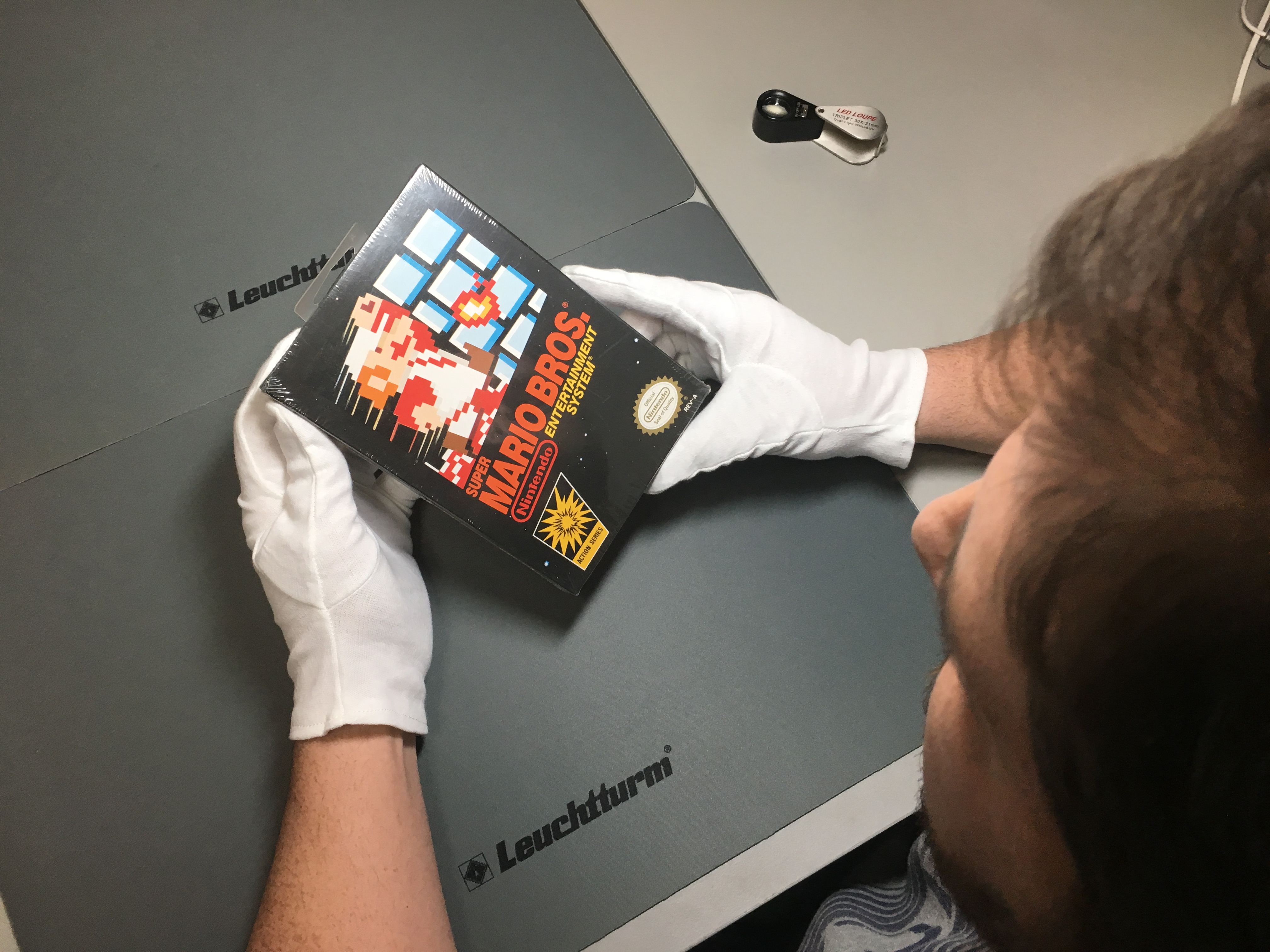 Wata Games' chief grader examines a sealed copy of Super Mario Bros..
Wata Games' chief grader examines a sealed copy of Super Mario Bros.. The grader looks through a jeweler's loupe to identify any signs of resealing, restoration, color touching, or tampering.Wata Games
The grader looks through a jeweler's loupe to identify any signs of resealing, restoration, color touching, or tampering.Wata Games Checking for seal and box authenticity.Wata Games
Checking for seal and box authenticity.Wata Games Yup, the box has a back. That checks out.Wata Games
Yup, the box has a back. That checks out.Wata Games Wata Games grading labels sit ready to be placed in their banners before the games are encapsulated.Wata Games
Wata Games grading labels sit ready to be placed in their banners before the games are encapsulated.Wata Games Snapping a label banner in place as part of the encapsulation process.Wata Games
Snapping a label banner in place as part of the encapsulation process.Wata Games Finally, the game is safe from routine handling damage (and from any chance of actually being opened and played any time soon).Wata Games
Finally, the game is safe from routine handling damage (and from any chance of actually being opened and played any time soon).Wata Games
Wata Games was also integral to this "professionalization" of high-end game collecting. The Denver-based grading service, founded in 2017, serves as Heritage's preferred grading partner, certifying that the sealed games Heritage sells are authentic and rating their condition on a scale that's already familiar to comic and card collectors. Wata also brought a new level of thoroughness to researching the games it graded; the company's list of all known variants of the NES' 17 initial "Black Box" titles was eye-opening even for long-time collectors. That work helped popularize the idea of identifying "first printings" in games by noting small differences on the boxes.
That attention to detail, along with the Heritage partnership, helped Wata take a lot of market and mindshare from VGA, an older game-grading service that Lewin referred to as "this weird black sheep of retro gaming shows for such a long time." Bronty says he remembers a toy dealer who tried to grow the market for VGA-graded high-end video games around 2008, "the thinking being, I believe, that action figure collectors and game collectors would have a lot of crossover and they'd use their existing clientele to cross people over. It never went anywhere. They were in and out, fast."
Heritage and Wata, on the other hand, brought instant credibility to an area that was previously a bit hard for outside collectors to parse. Unlike the scam-filled "Wild West" of eBay, where most big game sales used to happen, Kohler says Heritage is "making it very easy for people with a lot of money to get into collecting video games."
"There now is a trusted collectibles avenue for it that there wasn't before," Lewin said. "A lot of the people who are spending a lot of the money in this area have not been retro game collectors for 20 years or whatever, but they have maybe been comic collectors or sports card collectors and they know Heritage and trust Heritage [because] that's where they've been buying all the rest of their collectibles."
Flight to quality
The highlight of Heritage's first video game auction in January 2019 was a sealed Legend of Zelda that went for a then-significant price of $3,360. Just a month later, though, the co-chairman of Heritage was part of a group that spent $100,000 on a copy of Super Mario Bros., gaming's first six-figure individual game sale.
At that point, big-name collectors from other spheres started really paying attention, looking to get in on the ground floor of what they saw as a newly hot collectibles market. And those new collectors "just had this totally, totally different list of what was important in their heads," Kohler said. That includes a focus on first or early printings that were utterly unimportant to collecting's old guard. "Not only did [older collectors] not really care about... what's the first printing of Mario, what's the second printing of Zelda... they didn't really price their stuff based on that [because] they didn't even know," Kohler says. "They weren't even aware."
For these new collectors, hoarding unheralded games just because they're rare isn't really the point. Kohler summarized the new collectors' mentality: 'You shouldn't try to get this big junky set of all these random games that nobody cares about because nobody cares about them outside of the small circle.' But people do care about Mario and Zelda. So with Super Mario Brothers and Legend of Zelda, they're easy to find games, but they're not easy to find sealed."
“So if two people with a lot of money decide that they are going to be the one person to own [the top-graded copy of Super Mario 64], then they’re going to have their slap fight in the auction. And that’s what happened.”Chris Kohler
Even among the small subset of these games that are still sealed, the specific graded quality of each box can be supremely important. The record-setting Super Mario 64 received a 9.8/10 on Wata's scale, alongside a highest-possible A++ rating on the shrinkwrap seal itself. That is "effectively the highest grade one could hope their game to receive from Wata," Heritage Auctions' McLeckie said. While Wata does occasionally give "perfect 10" ratings, McLeckie said, "I could probably count them on 10 fingers maybe once or twice" across the entire hobby.
Even a game pulled fresh from the original shipping carton sent to stores decades ago might not be graded as a perfect 10 or even a 9.8 due to small imperfections in the production process, collectors told Ars. "That essentially means that barring some miracle, you're not going to have a nicer copy of Super Mario 64 [than a 9.8]," Kohler said. "So if two people with a lot of money decide that they are going to be the one person to own it, then they're going to have their slap fight in the auction. And that's what happened."
That kind of focus on quality has long been foreign to game collecting, Kohler added. "If you had a copy of a game that was like a $100 game, and you had the nicest one and it was super mint, but not sealed, could you try to charge $500 for it? You'd be laughed out of town because that's way too much of a premium."
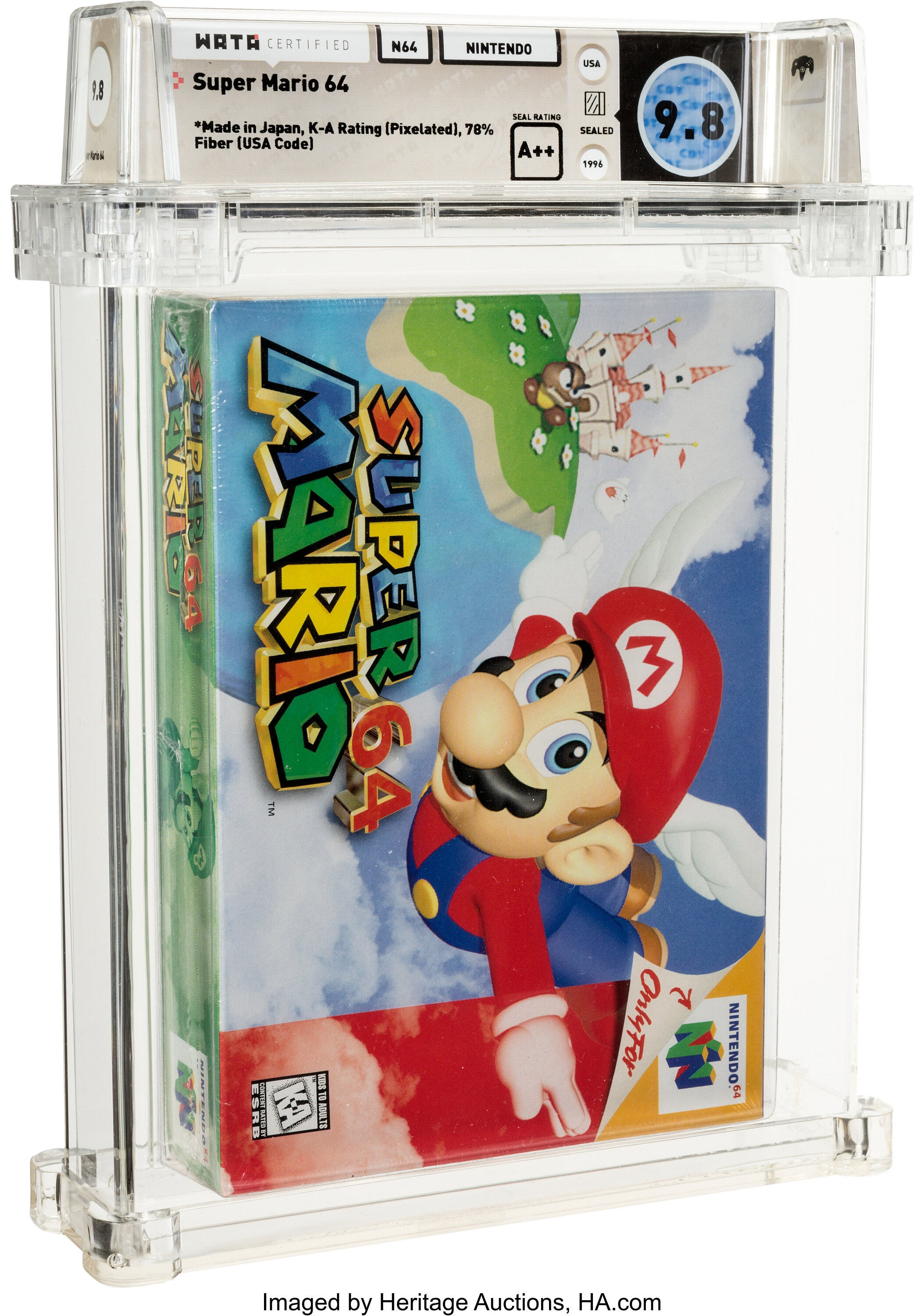 The Wata-graded 9.8 copy of Super Mario 64 that sold for $1.56 million.
The Wata-graded 9.8 copy of Super Mario 64 that sold for $1.56 million.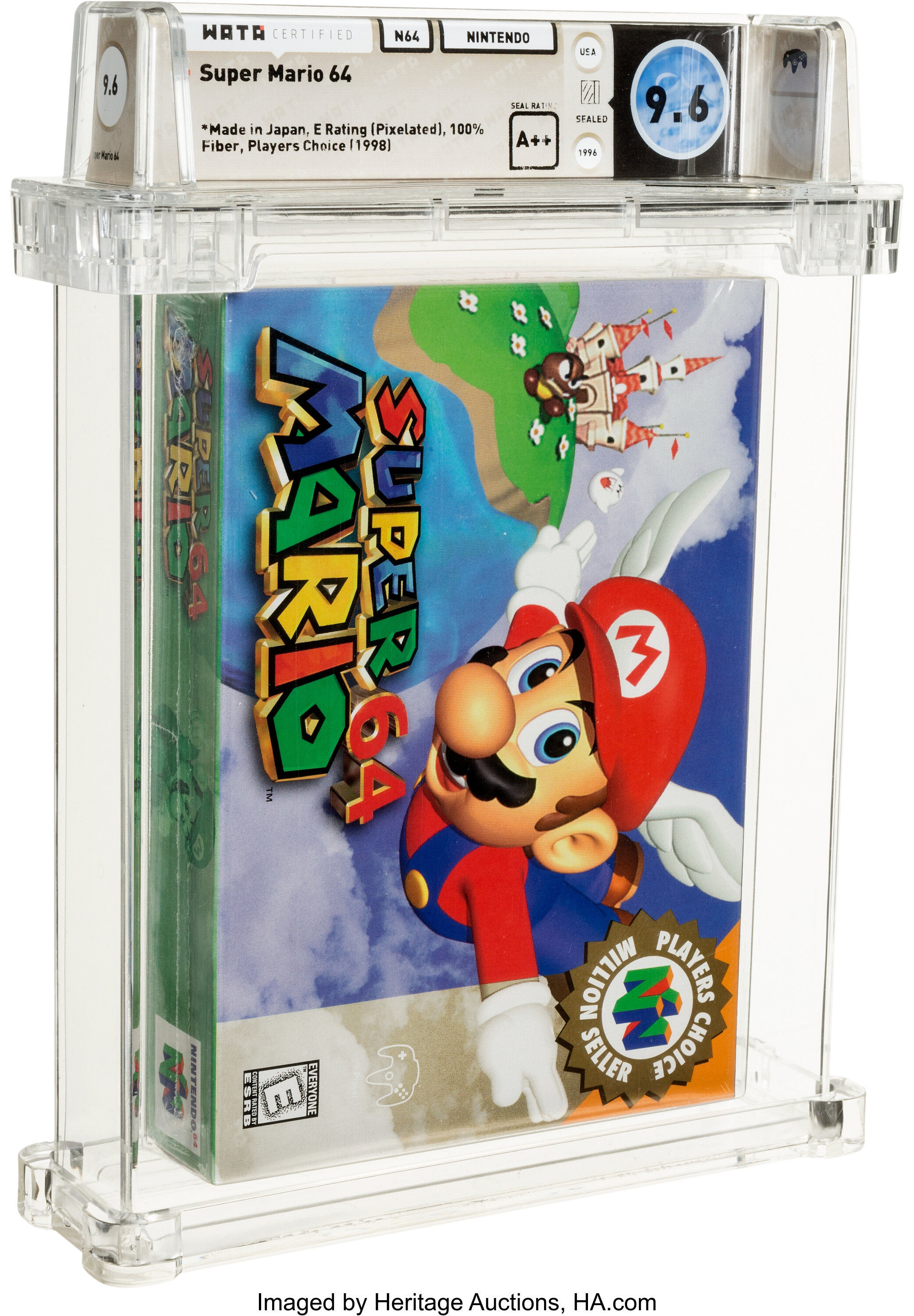 A nearly identical 9.6-graded Super Mario 64 that attracted just $13,200 at the same auction.Wata Games
A nearly identical 9.6-graded Super Mario 64 that attracted just $13,200 at the same auction.Wata Games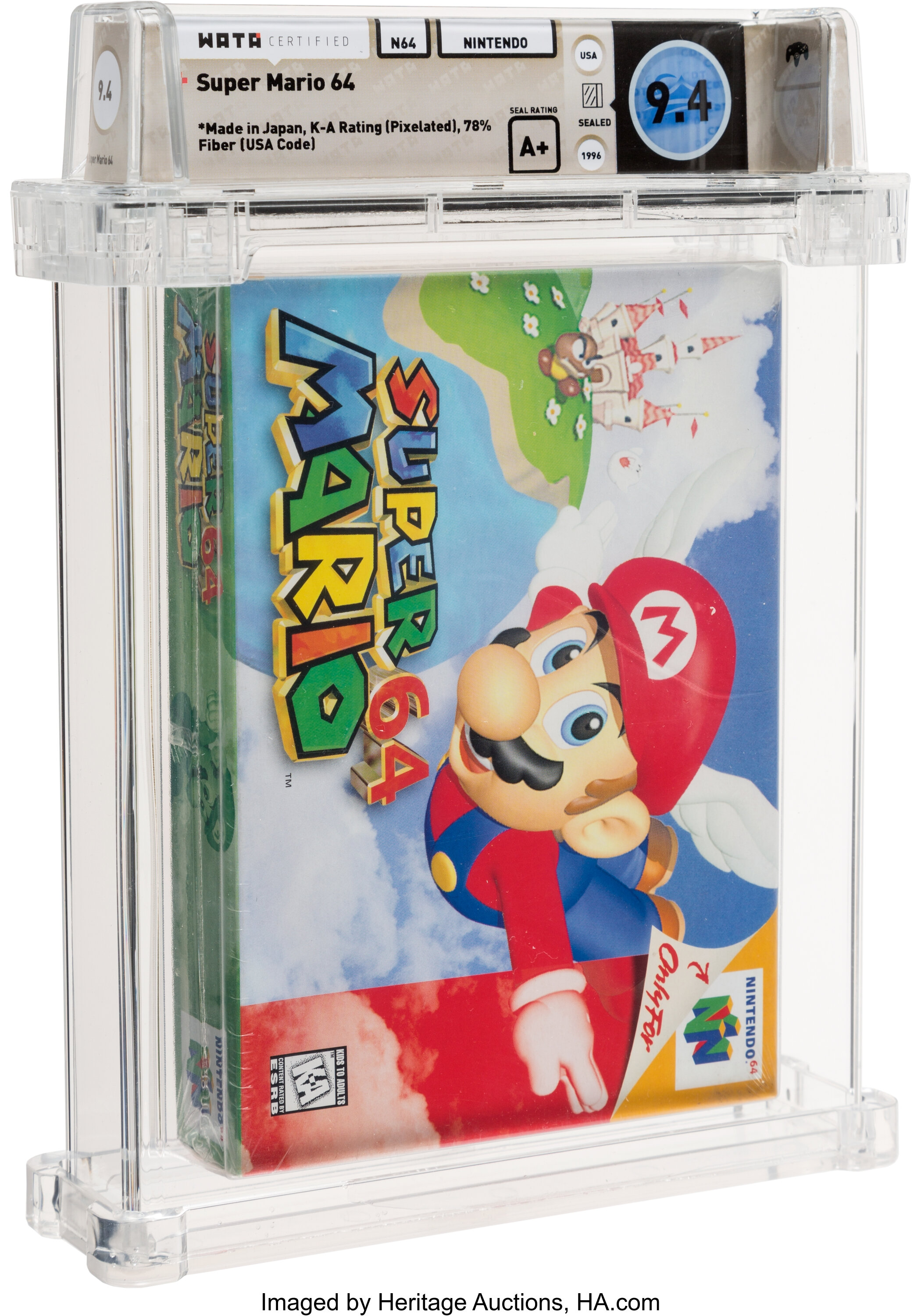 A 9.4-graded Super Mario 64 that sold for $38,400 with an A+ seal in January.Wata Games
A 9.4-graded Super Mario 64 that sold for $38,400 with an A+ seal in January.Wata Games An example of the A++ seal on the record-setting Super Mario 64.Wata Games
An example of the A++ seal on the record-setting Super Mario 64.Wata Games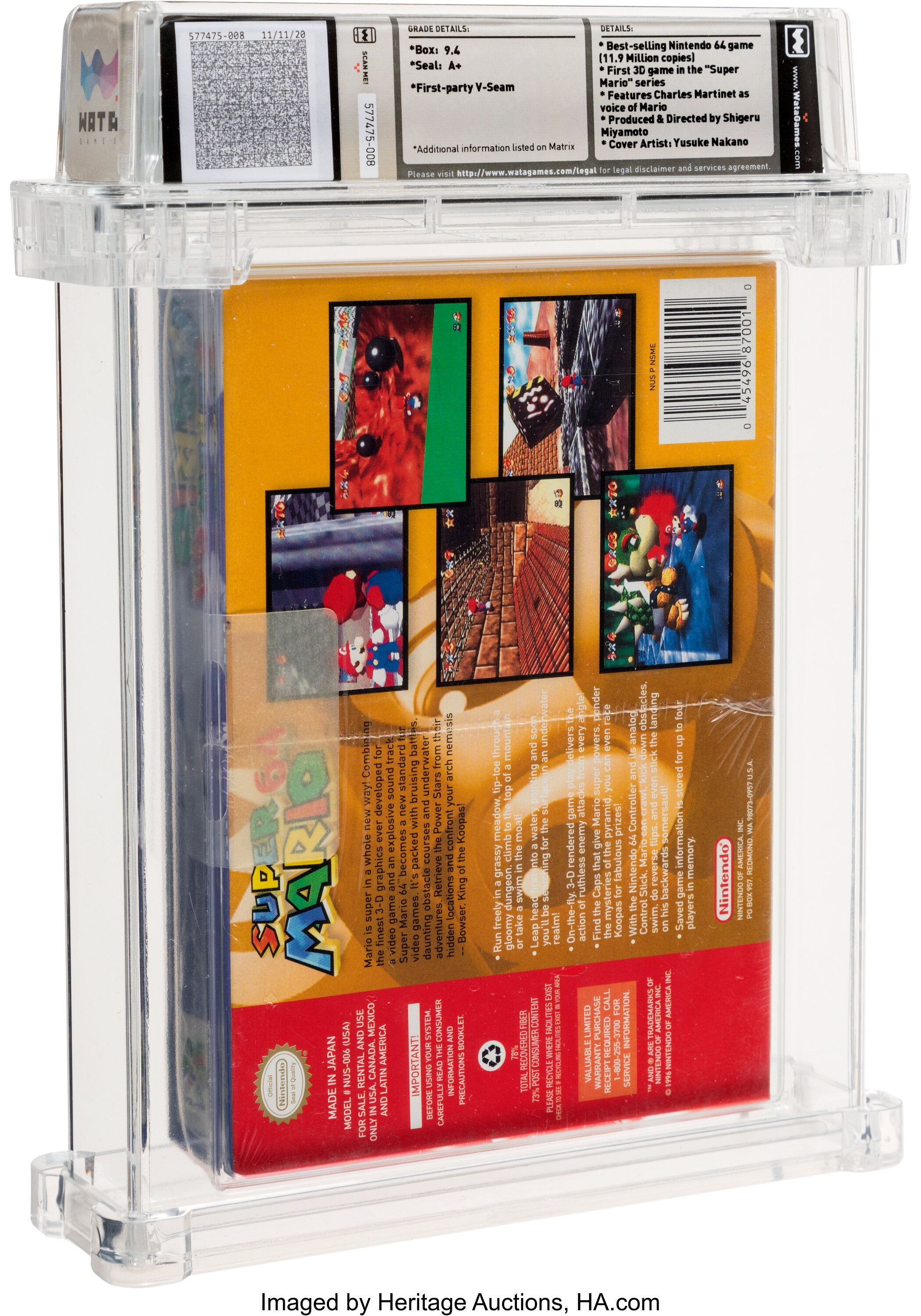 This seal ranks just an A+ on Wata's strict grading rubric.Wata Games
This seal ranks just an A+ on Wata's strict grading rubric.Wata Games
But for newcomers from other collectible spaces, this kind of quality-based price premium is relatively common. "In other spaces such as comics, coins, or sports cards, and many other collectibles, the difference between the second-highest grade and the highest grade can be a drastic difference in value and sometimes much more," Wata Games CEO Ryan Sabga told Ars. "Attaining the finest known example from a condition standpoint drives a certain type of collector's behavior, specifically the collector who wants the absolute best. The collectible video game market is no different."
The old guard vs. the new money
That influx of new money and new focus has caused what Kohler describes as "nonstop drama every day between the old-school collectors and the new-school collectors." One collector who sold sealed games at Heritage's latest auction (and asked for anonymity to avoid alienating fellow collectors—we'll call him Jim) said that "so many threads across Internet forums or social media pages over the years have quickly devolved into 'populist versus elitist' battles and hurling of insults back and forth."
“Attaining the finest known example from a condition standpoint drives a certain type of collector’s behavior, specifically the collector who wants the absolute best. The collectible video game market is no different.”Ryan Sabga
"As a long-time collector, there seems to be this divide where people hate the people who are grading games, saying it's ruining the hobby and stuff," Seattle Retro Game Expo Vice President Rob Schmuck said. "I think it's really this fear of being priced out. Pokémon games are a great example. There's somebody locally who's disparaging the price of Pokémon games. Well, you picked probably one of the most popular franchises right now, thanks to the card game having this resurgence and people really going in that... So I think it's a bit ironic to complain about that when you're the reason that the price is climbing."
Even some who collected sealed games before the current mania see a new culture clash developing. "There's a loss of control there," Bronty said. "In the past, it was a small-enough group that you felt like you understood the big sales and you knew exactly who was buying. You could often guess the buyer just from the item being sold. These days, who exactly is spending this kind of money is unclear. Card guys? Crypto money? The fractional-share platforms like Otis and Rally?"
Bronty said he's currently holding on to his complete collection of sealed NES games, partly out of a kind of market-driven paralysis. "Once prices get really high, you don't want to shell out that kind of money, so you're kind of locked out from buying," he said. "And you're sort of scared to sell when everything is doubling every three months. So, where in the hobby can you really participate or engage?... Essentially you can no longer participate."
“In the past, it was a small-enough group that you felt like you understood the big sales and you knew exactly who was buying... These days, who exactly is spending this kind of money is unclear. Card guys? Crypto money?”Bronty
Despite the culture clash, some feel that the newer sealed-game collectors are almost participating in an unrelated, parallel hobby to the old-school collectors. While loose cartridges and unsealed boxed games have increased somewhat in value during the pandemic, the new-money-driven mega-inflation in prices has been focused exclusively on sealed games that the old guard still barely cares about.
"I've always felt that there's a pretty clean separation between sort of the two different breeds of collector," Lewin said. "I would say that there there's a variety of opinions on it that range from feeling threatened and encroached upon to almost welcomed as, 'Cool, now there's people and they're just focusing on the sealed stuff and I don't care about that cause I want to play the games,' kind of thing."
"I personally believe there is, and always has been, room for everyone to find something they really enjoy about video games and focus on the positives," Jim said. "I am kind of caught in the middle now as a long-time gamer and collector participating in the [sealed-game] market, but most of all I just hope everyone can appreciate the art and historic values of these items in the way that best suits them..."
Known unknowns
In the old world of game collecting, resources like Mike Etler's NES rarity list helped collectors figure out what games might be worth spending a little extra to obtain. But Schmuck says lists like that "don't really capture the sealed rarity list." The focus on high-quality sealed games is so new in the collecting community that no one really knows for sure what games will end up being the rarest and most coveted or how many sealed copies even still exist for certain games and box variants at various graded conditions.
"That would set off a red flag to me as a buyer," Lewin said. "I'd be afraid to invest a lot of money in something that I don't know how many are out there... I think it's very unlikely that there [are] 10 more 9.8-rated [sealed Super Mario 64 copies], but I do think it's very possible there are many other high-graded ones out there."
One thing that could help settle that uncertainty is a public population report, where a grading company reveals how many copies of a certain game it has seen at various quality levels. These reports are common in more mature markets for high-end collectibles, and they help collectors know where their purchase sits on the rarity hierarchy.
“I’d be afraid to invest a lot of money in something that I don’t know how many are out there... I think it’s very unlikely that there [are] 10 more 9.8-rated [sealed Super Mario 64 copies], but I do think it’s very possible there are many other high-graded ones out there.”Kelsey Lewin
While VGA used to publish such population reports for its graded games, it stopped a few years ago before the intense interest in sealed games really took off. And despite so much pressure from the game-collecting world, Wata Games says it would be premature to start issuing similar population reports at this point in the development of the sealed-game market.
"While we have graded a significant number of games, it's really not enough to give a very clear picture of the population," Wata Games' Sabga said. That's in part because the games people send to Wata tend to be rare variants and not the less-popular, more common games, he continued. "If we release the population reports, they would show some potentially misleading information; it would show rare games as common and common games as rare. Eventually, things would settle out, but the reality is that it would cause undue turmoil in the marketplace in the short term."
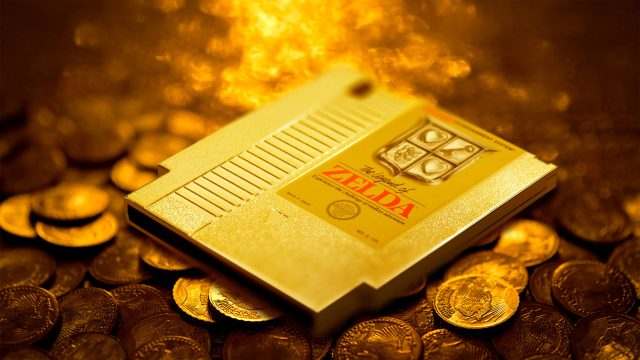
Not everyone agrees with that assessment. "I do think that having some information is better than having no information at all," Heritage's McLeckie said. "What would be really beneficial at this point, I think, is for everyone to have access to some sort of population data, because even though it isn't reflective of what could or could not be out there that's yet to be discovered, transparency for collectors is important for collectors to know how many of a certain title have been graded."
While Heritage asks Wata for population reports to share on specific games before its auctions, McLeckie said "their population data is not always available. They don't always share it with us." Data on Heritage's subset of auctioned games, by contrast, will always be public on its website, McLeckie said, because "we want collectors current and new to have as much information as possible to make them feel confident in the decision that they want to make when buying items for their collection."
"There is always the possibility someone has been hoarding items for decades off the radar, but for many reasons it seems highly unlikely," Jim said. "Certainly, if anyone has been doing that, we'll see an influx of new items after this past weekend!"
How high can this go?
Even with those caveats about imperfect knowledge, some collectors don't think this weekend's $1.5 million sale is completely ridiculous. "Let's speculate that within five years we get all the way up to 15 to 20 [Wata -graded] 9.8/A++ copies [of Super Mario 64]," Jim said. "Compared to other collectibles, that is still a very low population."
“I know somebody who said, ‘You almost can’t pay too much for sealed games’... and I think that that’s probably still true at this point.’”Rob Schmuck
In sports cards, for instance, population reports show only 318 known Fleer Michael Jordan rookie cards rated at a perfect 10 by grading service PSA. When it comes to Pokémon cards, only 122 first-edition Charizard cards have received that same perfect rating.
If those cards go for hundreds of thousands of dollars with supplies in the hundreds, who's to say pristine sealed games with populations in the dozens (or less) aren't worth many times more to the right collector? "What video game collectors might have considered 'common' amongst a much smaller subset of collectors can become very hard to attain very quickly as demand spikes," Jim noted.
That sort of belief is a big part of why there's been such a gold rush in sealed games these days and why "anything decent" in the space "is [worth] 10 times in 2021 what it was in 2019," as Bronty put it. The frenzy has gotten so strong that one collector told me of a sealed-game find that they recently sold for more than 200 times what they paid just a year ago (though they wouldn't let the specifics be reported on the record).
Most game collectors are skeptical that this rate of price inflation for high-end games can keep up at the same pace, and many think the trend will settle down soon. "Eventually, somebody is going to get caught with a hot potato," Kohler said. "This is not to say that they're going to spend $1 million on a game and it's going to be worth $0. But eventually, somebody will pay as much for it as will ever be paid."
After last weekend's record-breaking Heritage auction, nobody seems completely sure where the peak might be anymore. "There have also been signs in the prior few [Heritage] feature auctions that the proverbial dam could burst at any moment, usually the result of new high-end collectors entering a market, which clearly happened this past weekend," Jim said.
Could we see old video games selling for over $10 million in a couple years' time? Schmuck said the idea "does sound crazy now. But if you had told me two years ago that things would [happen as they have], I would have said you were crazy. I know somebody who said, 'You almost can't pay too much for sealed games'... and I think that that's probably still true at this point.'"
https://ift.tt/3evWVFb
Technology
Bagikan Berita Ini














0 Response to "Collectors are as confused as you are about that $1.56M Super Mario 64 sale - Ars Technica"
Post a Comment